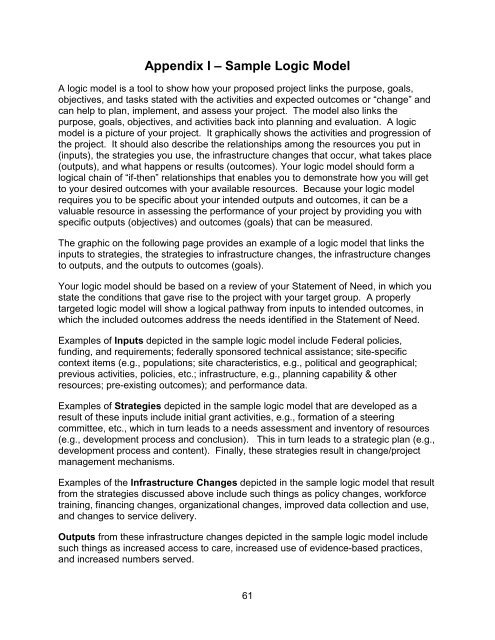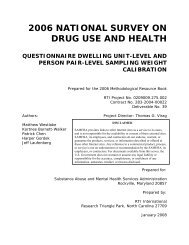Download Complete RFA Announcement (PDF | 351 KB)
Download Complete RFA Announcement (PDF | 351 KB)
Download Complete RFA Announcement (PDF | 351 KB)
You also want an ePaper? Increase the reach of your titles
YUMPU automatically turns print PDFs into web optimized ePapers that Google loves.
Appendix I – Sample Logic Model<br />
A logic model is a tool to show how your proposed project links the purpose, goals,<br />
objectives, and tasks stated with the activities and expected outcomes or “change” and<br />
can help to plan, implement, and assess your project. The model also links the<br />
purpose, goals, objectives, and activities back into planning and evaluation. A logic<br />
model is a picture of your project. It graphically shows the activities and progression of<br />
the project. It should also describe the relationships among the resources you put in<br />
(inputs), the strategies you use, the infrastructure changes that occur, what takes place<br />
(outputs), and what happens or results (outcomes). Your logic model should form a<br />
logical chain of “if-then” relationships that enables you to demonstrate how you will get<br />
to your desired outcomes with your available resources. Because your logic model<br />
requires you to be specific about your intended outputs and outcomes, it can be a<br />
valuable resource in assessing the performance of your project by providing you with<br />
specific outputs (objectives) and outcomes (goals) that can be measured.<br />
The graphic on the following page provides an example of a logic model that links the<br />
inputs to strategies, the strategies to infrastructure changes, the infrastructure changes<br />
to outputs, and the outputs to outcomes (goals).<br />
Your logic model should be based on a review of your Statement of Need, in which you<br />
state the conditions that gave rise to the project with your target group. A properly<br />
targeted logic model will show a logical pathway from inputs to intended outcomes, in<br />
which the included outcomes address the needs identified in the Statement of Need.<br />
Examples of Inputs depicted in the sample logic model include Federal policies,<br />
funding, and requirements; federally sponsored technical assistance; site-specific<br />
context items (e.g., populations; site characteristics, e.g., political and geographical;<br />
previous activities, policies, etc.; infrastructure, e.g., planning capability & other<br />
resources; pre-existing outcomes); and performance data.<br />
Examples of Strategies depicted in the sample logic model that are developed as a<br />
result of these inputs include initial grant activities, e.g., formation of a steering<br />
committee, etc., which in turn leads to a needs assessment and inventory of resources<br />
(e.g., development process and conclusion). This in turn leads to a strategic plan (e.g.,<br />
development process and content). Finally, these strategies result in change/project<br />
management mechanisms.<br />
Examples of the Infrastructure Changes depicted in the sample logic model that result<br />
from the strategies discussed above include such things as policy changes, workforce<br />
training, financing changes, organizational changes, improved data collection and use,<br />
and changes to service delivery.<br />
Outputs from these infrastructure changes depicted in the sample logic model include<br />
such things as increased access to care, increased use of evidence-based practices,<br />
and increased numbers served.<br />
61
















